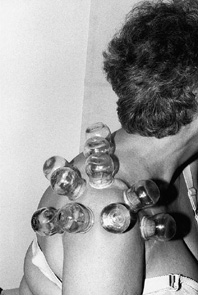Locomotor System
Rheumatic Disorders
“Rheumatism” is a collective term for diseases that affect particularly the joints and ligaments of the limbs, the spinal column, tendons, connective tissue, and muscle, but also the internal organs. A typical example is acute rheumatic fever, which can lead not only to polyarthritis, but also to heart or kidney disease.
Rheumatic diseases are today categorized in the following groups:
• Inflammatory rheumatism:
– Acute rheumatoid arthritis (rheumatic fever).
– Chronic rheumatoid arthritis (articular rheumatism).
– Bechterew disease (ankylosing spondylitis).
• Degenerative, non-inflammatory rheumatism:
– Arthrosis.
– Spondylosis and osteochondrosis.
• Soft tissue rheumatism:
– This includes partly inflammatory, partly degenerative processes that affect not the joints but the muscles, connective tissue, synovial bursa, tendon sheaths, and nerves.
Rheumatology distinguishes between two different types of pain, namely mechanical pain and inflammatory pain.
Mechanical pain generally appears during or after physical exertion, abates during rest, and completely disappears overnight. If stiffness does occur in the morning, it is very short and lasts a few minutes at most.
In contrast, inflammatory pain occurs also when the patient is resting. Generally, it flares up during the second half of the night and in some cases becomes so severe toward the morning that it awakens the patient. Inflammatory pain tends to be accompanied by ankylosis. This early-morning stiffness is persistent and painful, possibly lasting for more than half an hour. In contrast, ankylosis in conjunction with arthrosis generally lasts only a few minutes.
Acute Rheumatic Fever
Acute rheumatoid arthritis refers to a hypersensitive reaction (allergy) to pathogens, most commonly streptococcus bacteria. This condition manifests in sudden fever of up to 40°C (104 °F) in conjunction with very painful redness and swelling in the joints; the large and medium-sized joints (joints of the knees, feet, shoulders, elbows, and hands) are particularly affected.
A typical characteristic of this disease is that it wanders, from one joint to another. Also typical is profuse sweating. The sweat has a characteristic sour odor.
Shortly before the onset of acute rheumatoid arthritis, the patient often suffers from tonsillitis or catarrh of the nose, throat, and bronchial tubes. This disease most frequently affects children and young adults, but especially school children.
Treatment
Because of the severity of the disease and the danger of secondary developments, especially of rheumatic carditis, hospitalization is often necessary.
Inflammatory Chronic Rheumatoid Arthritis (Articular Rheumatism)
Chronic rheumatoid arthritis is also inflammatory, but not caused by pathogens. The cause is unknown. Because the chronic inflammation is self-perpetuating and hence does not heal, autoimmune processes have been suspected as formative. The disease can occur in all ages, but predominantly between the ages of 25 and 50, and affects women at three times the rate as men.
Symptoms
• As a rule, latent disease onset with joint problems that are at first undefined, such as stiffness in the finger and hand joints, especially in the morning after waking.
• Later, pain and swelling develops in the joints. The small joints on the hands and feet are involved first.
• In more advanced stages of the disease, the larger joints and parts of the cervical spinal column are also affected. Sooner or later, deformities develop in the hands and feet.
• Deterioration of general health, such as fatigue, exhaustion, lack of appetite, weight loss, abnormal sweating and mild anemia, sometimes slightly elevated body temperature.
Degenerative Rheumatoid Arthritis (Arthrosis)
Arthrosis is not an inflammatory disorder, but a degenerative joint disease that affects primarily the joint cartilage. The cause of arthrosis is a disproportion between the load and load-bearing capacity of the joint surfaces. In this process, the following factors play a role amongst others: congenital or injury-related malposition of the joints, congenital weakness of the cartilage tissue, previous joint inflammations, hormonal influences, excessive weight or strain. The disease is relatively widespread. It occurs mostly after the age of 40 and is slightly more common in women than in men.
In principle, it can affect any joint, but is most common in the load-bearing joints such as the knee, hip, and foot joints, and the small joints of the lumbar spinal column, followed by the shoulder, elbow, and hand joints.
Symptoms
• The first indications of arthrosis are stiffness and a feeling of tension after longer rest periods.
• Pain in arthrosis is predominantly mechanical. Pain during starting or warm-up that decreases with further movement is typical. Continuous strain, however, induces repeated pain.
• As the clinical picture of arthrosis progresses, bony enlargements may form in the joints, and you may here grinding or crackling noises. The motility of the joints is limited due to pain.
• Continuous sparing of the joint increases the danger of articular stiffness due to limited movement.
• Furthermore, lack of movement leads to poor circulation in the joint capsule and therefore to additional impaired nutrition in the already damaged cartilage.
Treatment of Rheumatic Disorders
Suggested Therapy
The treatment of rheumatic disorders with cupping (Figs. 11.1–11.4) pursues two goals:
• Eliminating the inflammatory symptoms and pain.
• Influencing metabolism, to slow down the decline in degenerative diseases and finally reach stabilization.
Painful Shoulder Stiffness (Periarthritis Humeroscapularis)

Fig. 11.1 Dry cupping around the diseased joint, in the area of the pain.
By stimulating circulation, cupping loosens the connective tissue, releases tension, and accelerates metabolism. It also relieves the manifestations of inflammation, and therefore the pain. Even serious changes are accessible to treatment, in spite of the fact that improvement can often be reached only very slowly.
• Treatment must be repeated for a longer period of time in intervals of initially 2–4 days, and afterwards of 8–14 days, until the goal is reached.
• Rubbing ointment on the treated skin areas prior to cupping increases the effect.
Stay updated, free articles. Join our Telegram channel

Full access? Get Clinical Tree





